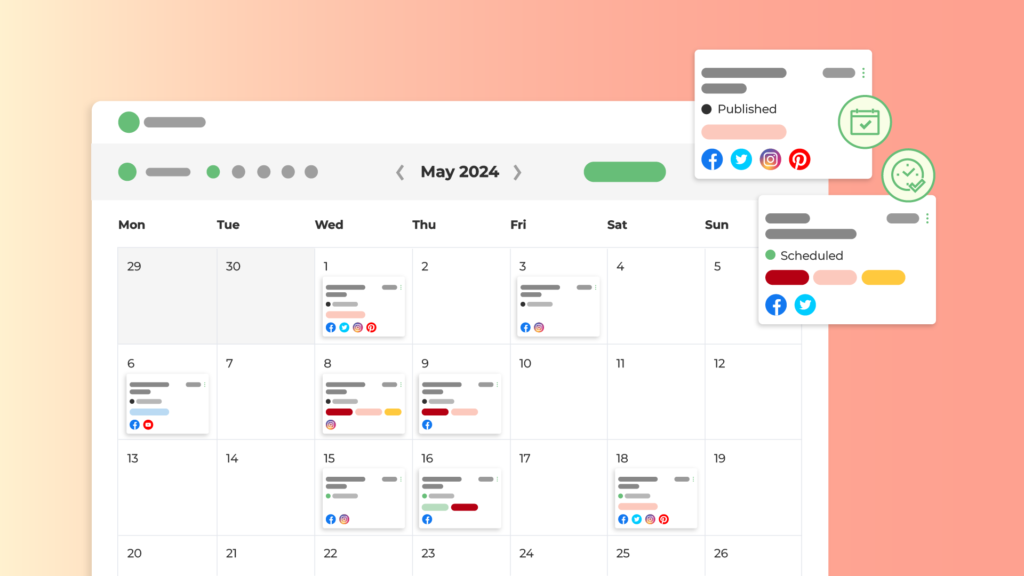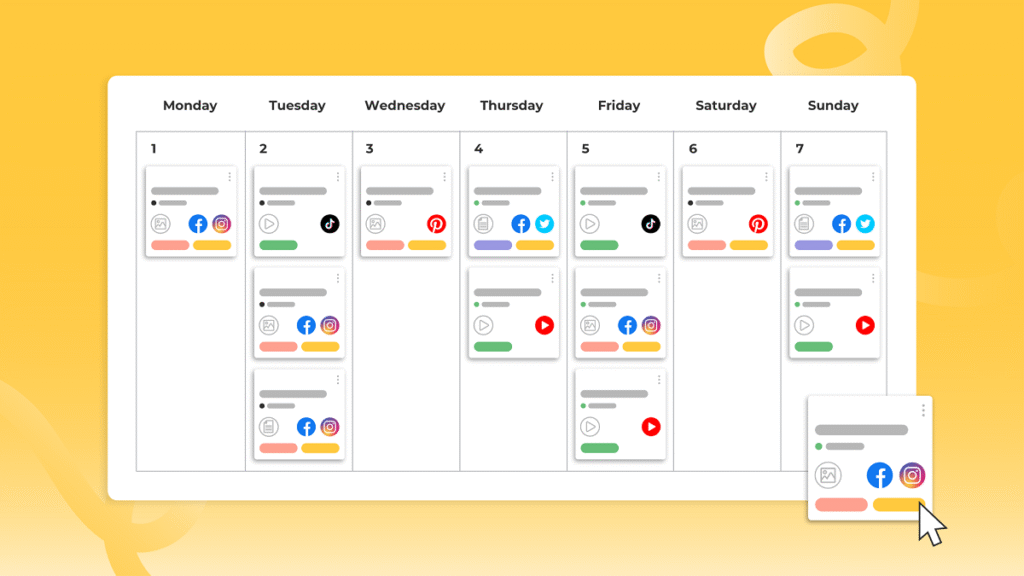A strategic tool that specifies what material will be released when is a content calendar. Maintaining consistency and coordinating your marketing activities requires knowledge of how to create a content calendar. 63% of companies, according to the Content Marketing Institute, lack a defined content strategy, which has a big influence on their capacity to meet marketing objectives.
Did you know that 72% of marketers say their content development processes are more efficient when they employ a content calendar? You can plan ahead and make sure you always have new material ready to post with the aid of a well-organized content calendar. Businesses that have a written content strategy have a higher chance of success with their marketing initiatives, according to HubSpot.
The fundamental content calendar procedures you need to follow to develop a strong plan will be covered in this tutorial. We’ll go over how to make a content calendar in easy stages and provide constructive advice to help you organize your content more efficiently. You may improve your marketing approach and get better outcomes by using these strategies.
Tips To Create A Content Calendar

1. Set Clear Goals
The first answer to how to create a content calendar is defining your content objectives. These objectives have to be in line with your overarching marketing goals, which can include raising engagement, generating leads, building brand recognition, or increasing website traffic.
Marketers who establish clear objectives are more likely to declare success, claims CoSchedule. Objectives provide guidance and aid in gauging success. For example, customize your content to draw in and convert prospective clients if your objective is lead generation. Clear, quantifiable objectives improve team performance and production, according to Sprout Social research.
You can make sure your content strategy is targeted and results-driven by establishing SMART (Specific, Measurable, Achievable, Relevant, Time-bound) standards. Setting defined objectives helps your company achieve significant outcomes by improving resource allocation and plan execution. Your content strategy and overall marketing efforts will be optimized if you put these content calendar recommendations into practice and adhere to the procedures.
2. Know Your Audience
Developing the steps to create a content calendar requires a thorough understanding of your target audience. Start by investigating the characteristics, inclinations, and habits of the audience. Data is provided by tools such as Google Analytics, social media analytics, and consumer surveys. The Harvard Business School reports that 68% of customers want individualized experiences, highlighting how crucial it is to understand your target market.
Examining your present clientele is a fantastic place to start. To find trends, examine demographics, past purchases, and engagement data. For instance, if young professionals make up your audience, concentrate on material that speaks to their lifestyle and professional development. Important insights and market gaps may also be found via competition analysis and market research.
Make thorough audience profiles using this data. By using these profiles, you can better customize your content to each segment’s unique requirements and interests, increasing effectiveness and engagement. Adapting your material to the tastes of your audience strengthens bonds and improves outcomes.
3. Select The Appropriate Equipment
Choosing the appropriate tools is key to creating a successful content schedule. You can effectively plan, schedule, and monitor your content with the aid of tools like Trello, Asana, and Google Calendar. Trello offers an easy-to-use interface with customizable boards for visual task and deadline management.
Asana provides collaborative workflows to facilitate teamwork and supports various views, including calendar and list styles. Consider ContentStudio for a more feature-rich choice. It provides statistics to track interaction and interfaces with several social media networks.
With features like collaborative proofreading and scheduled task reminders, Smartsheet is another powerful tool that’s perfect for sophisticated organizations. Canva Pro integrates design and scheduling features, making it an affordable option for visually stimulating content strategy if your budget permits.
4. Arrange Topics And Themes for the Content
The secret to sustaining audience attention and accomplishing your marketing objectives is using consistent themes and subjects for your content. Begin by coming up with ideas for subjects that will appeal to your audience and fit with your objectives.
To find pertinent subjects, use tools for competitive analysis, social media trends, and keyword research. For instance, social listening tools may show you what your audience is interested in and what subjects are popular, while keyword tools can assist you in identifying high-traffic themes that your audience is looking for.
Create a content strategy when you have decided on your themes. For example, if your area of expertise is health and wellness, write a number of articles, videos, and social media posts on relevant subjects like mental wellbeing, exercise advice, and healthy recipes. This strategy guarantees a coherent and captivating story.
Organizing your material according to topics keeps your audience interested and helps you develop a consistent brand voice. Additionally, it simplifies the process of creating content, which makes it simpler to keep up a consistent supply of high-quality material.
5. Conduct A Social Media Audit
Evaluate the performance of your existing content before thinking about how to create a content calendar. This entails determining which information is still operating effectively, which needs to be updated or archived, and which is completely absent.
You could see, for instance, that your LinkedIn interaction declines every Friday or that your behind-the-scenes reels on Instagram surpass product photographs when you open Sprout’s Post Performance Report. These insights assist you in deciding what should remain the same, what should be altered, and where important gaps should be filled.
Sprout’s integrated performance reporting for every linked profile makes auditing simple. To see all of your account and profile performance statistics, choose the Reports option from the left-hand navigation bar.
6. Schedule Your Content
Choosing the ideal publishing time is one of the essential steps to create a content calendar. By examining your audience’s online behavior, you can determine when they are most engaged and make sure your material is seen as much as possible.
According to research, the most interaction is often obtained while publishing on weekdays, especially in the mornings and early afternoons. For instance, on Tuesdays and Wednesdays, Instagram postings do best between 10 AM and 2 PM.
Plan your posts for when your audience is most engaged by using tools like Sprout Social or Hootsuite. These programs may suggest the best times to publish by analyzing engagement statistics. To keep your audience interested and prevent boredom, mix up your blog articles, videos, and social media updates.
Make sure your publishing schedule is in line with your objectives and the preferences of your audience by reviewing it often. Maintaining consistency, preventing content gaps, and optimizing the effect of your marketing activities are all made possible by a well-planned timetable.
Read More: 9 Content Planning Tools for Marketing Success
7. Assign Responsibilities
For content creation to go well, your content team’s roles and duties must be clearly defined. Clearly state who is in charge of creating, editing, approving, and releasing the information. To make duties clearer, use a RACI matrix: Responsible, Accountable, Consulted, and Informed. This prevents misunderstanding and guarantees that everyone is aware of their responsibilities.
Delegating effectively guarantees that activities are finished on schedule and to a high level. Asana and Trello are two examples of tools that may be used to monitor work and improve communication. Frequent feedback sessions and team meetings help everyone stay on the same page with the content strategy and quickly resolve any problems.
For instance, designate marketers for publication and marketing, editors for quality control, and a project manager to supervise the whole process. This methodical approach guarantees constant delivery, prevents bottlenecks, and expedites the creation of your content. By delegating precise tasks, you establish a well-structured workflow that boosts output and maintains the high standards of your content strategy.
8. Track and Modify Your Schedule
To maximize your approach and accomplish your objectives, you must regularly check your content schedule. Measure important performance indicators like engagement rates, traffic, and conversions by using analytics programs like Google Analytics, Semrush, and Sprout Social.
You can determine which content kinds are effective and which need improvement by examining these stats. According to HubSpot, 60% of marketers who routinely review their KPIs report improved content performance.
Think about producing more of a certain kind of content if it’s doing well. For example, when it comes to learning about goods, 73% of customers prefer short-form videos, which also provide the best return on investment.
Constant observation enables you to remain flexible and adapt to audience tastes, guaranteeing that your material stays current. Maintaining a dynamic and successful content strategy through frequent data-driven tweaks maximizes the impact of your marketing initiatives.
Provide Excellent Ideas For Your Content Calendar
You’ve certainly accumulated a multitude of unique ideas for how to create a content calendar, but the next key issue is: how do you identify which ideas will actually connect with your audience and concurrently increase your SEO strategy?
The basic solution is in keyword research. While brainstorming helps you come up with new, unique content ideas, keyword research ensures those ideas correspond with the real search phrases your audience is using. Without keywords that match what people are looking for, even the most amazing content ideas might go overlooked.
So, how do you undertake successful keyword research? Start by finding high-traffic, low-competition keywords that are relevant to your sector and audience. Tools like Google Keyword Planner, SEMrush, and Ahrefs are excellent for identifying keywords relevant to your subject. These tools can help you uncover both core and long-tail keywords, which may give your content the edge it needs to rank better.
Once you’ve selected the proper keywords, it’s crucial to evaluate search intent. Are users seeking information, a product, or a service? Understanding this helps you develop content that not only ranks but also serves the demands of your audience. Additionally, pay attention to keyword difficulty—a high difficulty number may imply you’re up against intense competition, while a lower score gives a chance to rank quickly.
Incorporating studied keywords intelligently into your titles, headers, and article body will guarantee your ideas aren’t simply distinctive but also findable by your audience, enhancing both engagement and SEO performance.
FAQ
Q: What role does a content calendar play in my marketing plan?
A: Making a good content calendar helps you plan ahead, maintain consistency, and stay in line with your marketing objectives.
Q: How often should my content calendar be updated?
A: At least once a month, you should change your plan to maintain it current and relevant.
Q: Which typical errors should be avoided while making a content calendar?
A: To guarantee efficacy, steer clear of ambiguous objectives, disregard analytics, and neglect to update your schedule on a regular basis.







